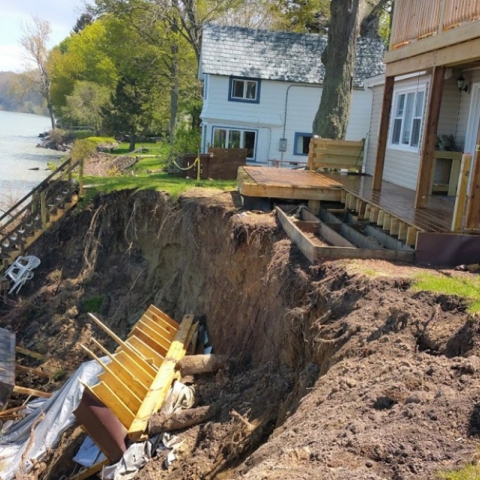
Three grants from the New York Sea Grant (NYSG), a National Oceanographic and Atmospheric Administration (NOAA) program, will aid Cornell coastal science research projects along the Great Lakes.
Researchers in the College of Agriculture and Life Sciences received more than half of the $1.1 million in grants announced by NYSG for two-year coastal science research projects.
Cornell projects will focus on Great Lakes coastal flooding and aquatic invasive species detection, and developing ways to help seafood processors fine-tune their listeria food safety control strategy.
Tools to help coastal communities address flood risk and planning:
Scott Steinschneider, assistant professor in the Department of Biological and Environmental Engineering, will use a $237,431 grant to develop models of extreme lake levels, storm surges and wave heights to help predict flooding events, such as the high water events along Lake Ontario in 2017. Social science data will supplement development of decision-support tools for flood risk and planning.
Enhancing aquatic invasive species detection with e-DNA:
David M. Lodge, director of the Atkinson Center for a Sustainable Future and a professor in the Department of Ecology and Evolutionary Biology, received $239,630 to develop an inexpensive environmental DNA-testing method for earlier detection of aquatic invasive species, and co-detection of multiple species to assist coastal resource managers at less cost than current detection methods. Field testing will take place on lakes Erie and Ontario.
Amplifying food safety for salmon processors:
Dr. Martin Wiedmann, the Gellert Family Professor in Food Safety in the Department of Food Science, received $170,000 to assess how listeria grown under different processing conditions before contamination of salmon differs in susceptibility to the antibacterial compound nisin. Listeria contaminates a variety of foods at levels unlikely to cause disease, but can grow to dangerous levels. The research of Wiedmann and postdoctoral associate Veronica Guariglia will take into account natural growth conditions that listeria is exposed to in seafood processing facilities. The goal is to help processors in the Great Lakes and downstate saltwater regions of New York customize their use of nisin for cold-smoked salmon product packaging.
The projects are sponsored by New York Sea Grant, a cooperative program of Cornell and the State University of New York and one of 33 university-based programs in NOAA’s National Sea Grant College Program.
“New York Sea Grant is pleased to sponsor this new research that is vital to protect and enhance the quality of New York state’s water resources, which are an essential economic driver not only for our coastal communities in the Great Lakes region but for all of New York state,” said Katherine Bunting-Howarth, associate director of New York Sea Grant Institute and assistant director of Cornell Cooperative Extension.
Kara Lynn Dunn is publicist for New York Sea Grant Great Lakes Extension.
